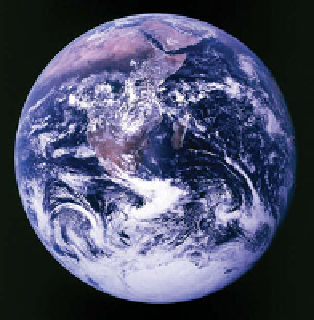Geoscience Reference
In-Depth Information
Table 12.2.
Equilibrium and actual temperatures of the surfaces of planets, dwarf planets, and the moon
Major
atmospheric
gases (volume
mixing ratios)
Distance
from sun
(10
9
m)
Equatorial
radius
(10
6
m)
Surface
pressure
(bars)
Equilibrium
temperature
(K)
Actual
temperature
(K)
Object
Albedo
2
×
10
−
15
Mercury
57.9
2.44
He (0.98),
H(0.02)
0.11
436
440
Ve nus
108
6.05
90
CO
2
(0.96),
N
2
(0.034),
H
2
O(0.001)
0.65
252
730
Earth
150
6.38
1
N
2
(0.77),
O
2
(0.21),
Ar (0.0093)
0.30
255
288
Moon
150
1.74
2
×
10
−
14
Ne (0.4),
Ar (0.4),
He (0.2)
0.12
270
274
Mars
228
3.39
0.007
CO
2
(0.95),
N
2
(0.027),
Ar (0.016)
0.15
217
218
Jupiter
778
71.4
>
100
H
2
(0.86),
He (0.14)
0.52
102
129
Saturn
1,427
60.3
>
100
H
2
(0.92),
He (0.74)
0.47
77
97
Uranus
2,870
26.2
>
100
H
2
(0.89),
He (0.11)
0.51
53
58
Neptune
4,497
25.2
>
100
H
2
(0.89),
He (0.11)
0.41
45
56
1
×
10
−
5
Pluto
5,900
1.5
?
0.30
41
50
Sources:
Data compiled from Lide (1998), except that equilibrium temperatures were calculated from Equation 12.6.
(a)
(b)
(c)
Figure 12.3.
(a) Ultraviolet image of Venus's clouds as seen by the Pioneer Venus Orbiter, February 26, 1979.
Available from National Space Science Data Center. (b) Earth as seen from the Apollo 17 spacecraft on
December 7, 1972. Available from National Space Science Data Center. (c) Image of Mars taken by Hubble
telescope on March 10, 1997. The North Pole dry ice cap is rapidly sublimating during the Martian Northern
Hemisphere spring. David Crisp/WFPC2 Science Team, Jet Propulsion Laboratory/California Institute of
Technology; available from National Space Science Data Center.









Search WWH ::

Custom Search